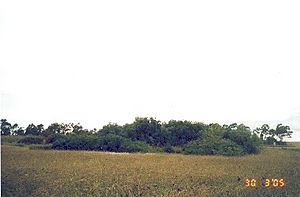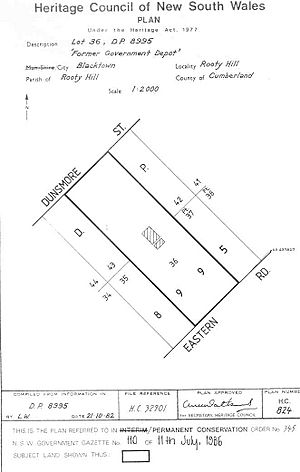Government Depot Site, Rooty Hill facts for kids
Quick facts for kids Government Depot Site |
|
|---|---|

View of the site from Dunsmore Street, looking southwards towards Rooty Hill, with the vegetated area marking the house site
|
|
| Location | Dunsmore Street, Rooty Hill, City of Blacktown, New South Wales, Australia |
| Built | 1815–1819 |
| Owner | Department of Planning and Infrastructure |
| Official name: Government Depot Site (former); Government Depot Ruins; Thornleigh; Stratton; Rooty Hill Government Farm | |
| Type | state heritage (complex / group) |
| Designated | 2 April 1999 |
| Reference no. | 345 |
| Type | Homestead Complex |
| Category | Farming and Grazing |
| Builders | Not known |
| Lua error in Module:Location_map at line 420: attempt to index field 'wikibase' (a nil value). | |
The Government Depot Site is a special historical place in Rooty Hill, New South Wales, Australia. It was once a big farm where the government kept its animals, like cattle and horses. The main building, a two-story brick house, was built between 1815 and 1819. This site is also known by other names, like Government Depot Ruins or Rooty Hill Government Farm. Today, it's an archaeological site, meaning experts can find clues about the past here. It's protected as part of the New South Wales State Heritage Register because of its important history.
A Look Back at Rooty Hill's Past
Where Did the Name "Rooty Hill" Come From?
People have wondered for a long time how Rooty Hill got its name! One idea is that when the nearby Eastern Creek flooded, it left lots of roots and other bits of plants on the bare fields. This made the area look "rooty."
Another idea comes from Captain J. H. Watson, who had lived in India. He thought the name came from "ruti," a word for bread in India. However, the Rooty Hill site was mostly for animals, not for growing crops like wheat for bread. So, this idea might not be right.
Governor Macquarie's Farm
The area was mainly used as a government farm for animals. Governor Macquarie, who was the Governor of New South Wales from 1810 to 1821, made a list of all the buildings and projects he had completed. On his list, he mentioned what was built at Rooty Hill:
- A two-story brick house for the farm's manager. It also had a special room for the Governor to use when he visited.
- A kitchen, stables, and other small buildings.
- A fenced kitchen garden.
- Four large fenced areas, each about 50 acres, for young cattle to graze. These areas were also used to grow wheat and corn for the farm workers.
- Simple log huts for about 20 stockkeepers (people who looked after the animals). These huts also had small gardens.
Governor Macquarie believed that the Rooty Hill farm was very important. It was the second most important government farm for cattle and horses, after the one in Camden. He thought the land, which was about 6,000 acres, was excellent. It was also in a good spot, on the Great Western Road, and only 10 miles from Parramatta. Because of this, he said the land should never be sold by the government.
Land Grants and New Names
However, Governor Macquarie later gave away some of this land. In 1821, Major Druitt received 1,000 acres from the Rooty Hill farm. This area is now known as Mount Druitt. In 1824, Captain P. P. King, whose father was Governor King, also received 1,500 acres from the farm.
On January 11, 1822, a man named T. H. Hawkins arrived in Sydney with his family. A few months later, he was given a job in Bathurst. On April 5, he and his family set off from Sydney, traveling with wagons and carts over the Blue Mountains. They reached Rooty Hill late that night, about 25 miles from Sydney. The government house was ready for them.
Hawkins loved the place, saying, "I could have been contented to remain there for ever - the house was good, and the land around like a fine wooded park in England."
What Happened to the House?
The "brick built house of two stories" was still standing in 1935. Photos from that time show it had a metal roof, but it probably had a shingle roof (made of wooden tiles) originally. There was also a large oak tree nearby, which would have been small when Governor Macquarie was around.
Over time, the site was known by other names like "Thornleigh" and "Stratton." By the 1960s, the house was in ruins and was eventually pulled down.
Old photographs from 1935 show the "old homestead" with two chimneys on each end. There was also a large oak tree with a fenced area around it.
What Remains Today?
The Government Stock Farm was originally about 6,000 acres. The main building was the manager's house, built in 1815. This house was also used by Governor Macquarie and other travelers passing through.
Today, if you walk around the area where the house used to be, it's mostly overgrown with thorn bushes. You can't see much of the original buildings above the ground. The only things found so far are some old timber fence posts and a large brick pit covered in cement, which might have been a well. This pit is now filled with various items and rubbish. You can still see hints of where the house's garden used to be.
In 1992, a list described what was left of the depot, including piles of bricks, stone paving, timber slabs, and a 5-meter-wide well. However, apart from the well, most of these things are no longer visible and might not have survived.
Current Condition of the Site
As of 2000, the old house was in ruins. It's hard to tell its exact condition because the site is very overgrown. However, the site is very important for archaeology because of its past as a government farm.
It's believed that very little of the original buildings are left. The manager's house is not "intact," meaning it's not complete. But the site still has the general shape and parts of the house's garden, as well as the open space from the old farm.
Not much is known about the site, and a detailed survey hasn't been done yet. Because of its history and connection to Governor Macquarie, more investigation is needed. It's important to find out what's left and document it carefully.
Why This Site is Important
The Government Depot site is important for its connection to Governor Macquarie and for being the home of the stock farm's manager. It also has local importance because of its link to early travelers and settlers in the area.
In the early 1800s, the Rooty Hill farm was the second most important government station for grazing cattle and horses, after Camden.
The Government Depot Site was added to the New South Wales State Heritage Register on April 2, 1999, because it meets several important criteria:
Showing Our History
The Government Depot site is historically important because it's connected to Governor Macquarie and other early settlers and travelers in the Blacktown/Rooty Hill area. It's also important for its past role as a government farm. As part of the government farm, it was the second most important government station in the colony.
Unique Beauty and Design
The site still has parts of the original 6,000 acres of the Government Stock Farm. As an open, "rural" space, it has some beauty and is quite rare in modern Western Sydney.
The manager's house site has very little of its original structure left. However, it still has the overall shape and parts of the manager's garden. So, its beauty is mostly in its open space and historical layout.
Community Connections
The Government Depot is socially important because it's linked to early settlers and travelers in the Blacktown/Rooty Hill area. It also played a big part in raising animals for the young colony and helped with early industries in the area. It would have provided jobs for many early settlers.
Learning from the Past
The Government Depot site could be technically important if any early structures are found. It could also teach us about early farming and animal raising methods. Any remains found could show us the sizes and shapes of fields, what fences were made of, and what animals and crops were grown.
Rare and Special History
The site still has parts of the original 6,000 acres of the Government Stock Farm. As an open, "rural" space, it has some beauty and is quite rare in modern Western Sydney. As part of the Government Stock Farm, it was the second most important government station in the colony, after Camden.
A Great Example of Its Kind
The Government Stock Farm was one of the two most important stations in the colony in the early 1820s. It still has the potential, through its archaeological remains, to show us a good example of a colonial-era farm with typical farm features from that time.




